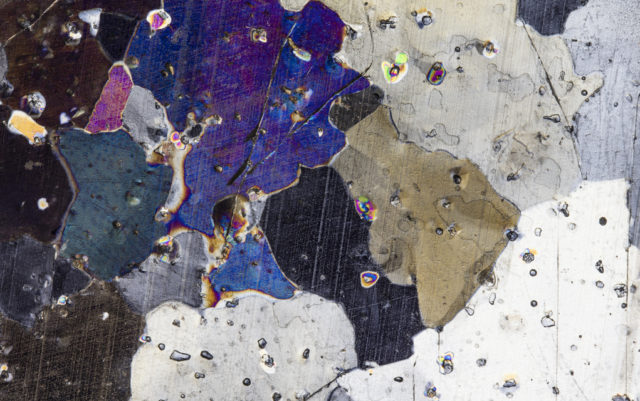
Dirk Hobman wants to take people on a journey through time, drilling down through frigid layers of history, past the era of the first Homo sapiens, to 200,000 years ago. That’s where his work begins.
Merging his backgrounds in ecology and photography, Hobman tells stories of the natural world. His most recent project, “The Color of Ice,” takes viewers into the frozen annals of ice cores, turning them into colorful masterpieces of paleoclimatology. The project hinged on his ability to sell the idea to the archive at the National Science Foundation Ice Core Facility in Lakewood.
Hobman is one of just a handful of artists who have been granted access to the archive to capture images of the priceless specimens held there. The facility houses an incredible 19,000 meters — nearly 12 miles — of ice core samples from Greenland, Antarctica and North America.
“It’s like the coldest place on the planet, and it’s right here,” says Hobman, smirking at the irony of pursuing such a project, all while admitting to skiing only in the spring to avoid the unpleasant conditions of winter.
Ice cores are cylinders of ice 2-6 inches wide and up to 2 miles long. They are typically drilled out of Arctic and Antarctic glaciers formed over time as each year’s snowfall turns into a layer of ice that then gets covered and compressed by the next year’s snowfall, on and on for millennia. The ice, therefore, contains a yearly graph of data, similar to that of a tree ring but going back much further, possibly millions of years.
Most ice cores that are drilled around the world get shipped to the facility in Lakewood for processing, making the Front Range somewhat of a hub for climate research.
A tour of the facility is offered to the public, with the main attraction being a massive freezer held at negative 32 degrees Fahrenheit in order to keep the samples from melting and releasing the ancient air trapped within them. Geoffrey Hargreaves, curator of the collection for nearly 30 years, is cut out for the job as tour guide, walking leisurely into the freezer, past a cardboard cutout of Mr. Freeze, through the aisles of the main archive.
Outside the freezer is a rack of extreme weather gear, untouched by Hargreaves and noticeably unoffered to those in the tour who are mostly dressed for school or work. Alas, the gear is meant only for the researchers who handle the samples in the adjacent exam room, which is held at a relatively balmy negative 11 degrees.
Hargreaves says researchers have captured ice believed to be up to 800,000 years old, though the facility holds samples only going back 400,000 years, which were taken from a site in Antarctica where the coldest temperature on Earth — negative 129 degrees — was recorded.
Core samples must travel precariously from their home in a remote ice sheet, via a cargo carrier and tagalong refrigerator mechanic, to Colorado. Once at the facility, the cores are left untouched to stabilize in their new climate, then eventually unpacked and cut with a saw to specific dimensions before being shipped off to climate research labs around the world.
In his presentation to the tour group, Hargreaves shows a graph comparing historic levels of carbon dioxide and temperature change from 400,000 years ago to the present. The image spikes dramatically at the end after fluctuating in an upward trend from the start, as the Earth has warmed and cooled, with the decades since 1950 beginning an ongoing ascension beyond any other past measurements.
Hargreaves calls himself a science absolutist, but is happy to see artists like Hobman get creative with the ice.
Hobman uses a macro lens to zoom in on the ice samples and show their crystalline structure and microscopic bubbles of ancient air. He ends his series, though, with an image of the dark rippling water of the Arctic Ocean, reminding viewers about the current reality of rapidly melting glaciers and thinning pack ice in the far North.
After a stint in the Gregory Allicar Museum of Art at CSU Fort Collins, Hobman’s alma mater, “The Color of Ice” found its permanent home in the place where it all began: the ice core facility.
“Pretty cool,” Hobman says, unable to resist the pun.














